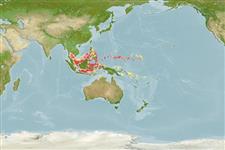>
Eupercaria/misc (Various families in series Eupercaria) >
Labridae (Wrasses) > Cheilininae
Etymology: Cirrhilabrus: Latin, cirrus = curl fringe + Greek, labros = furious (Ref. 45335); earlei: Named in honor of John L. Earle who collected the holotype.
Eponymy: John L Earle is a founder member of the Association for Marine Exploration. [...] (Ref. 128868), visit book page.
More on authors: Randall & Pyle.
Environment: milieu / Klimaatzone / Diepte / distribution range
Ecologie
marien rifbewoner; diepte 60 - 110 m (Ref. 41654). Tropical
Western Central Pacific: Palau and Micronesia.
Lengte bij maturiteit / Grootte / Gewicht / Leeftijd
Maturiteit: Lm ?, range 5 - ? cm
Max length : 6.9 cm SL mannelijk / geslacht onbekend; (Ref. 41654)
Korte beschrijving
Determinatiesleutels | Morfologie | Morfometrie
Dorsale stekels (totaal) : 11; Dorsale zachte stralen (totaal) : 9; Anale stekels: 3; Anale zachte stralen: 9; Wervels: 25. This species is distinguished by the following characters: D XI,9; A III,9; pectoral fin rays 15; dorsal fin with progressively longer spine where the 11th is 2.4-2.6 in head; in males the interspinous membranes do not extend above the spine tips; pelvic fins of male short 4.05-4.9 in SL; rounded to rhomboid caudal fin; lateral line scales 16-17 + 5-6; median predorsal scales 4-5; cheeks with 2 horizontal rows of scales; colour in life pale red, shading to pale yellow on abdomen, with deep red longitudinal lines on body following scale rows (persists as lavender to purple when preserved); head with two deep pink bands, one from upper lip passing over eye to origin of dorsal fin, the other from lower lip along mandible to corner or preopercle; operculum yellow; dorsal fin yellow anteriorly with a black spot on first membrane, spines red; rest of fin and caudal fin light red with deep red rays; pelvic fins yellow with red spines and rays (Ref. 41654).
Body shape (shape guide): fusiform / normal; Cross section: compressed.
Inhabits mixed coral, rubble, and sand slopes along the bases of steep protected seaward reefs (Ref. 37816). Maximum depth reported taken from Ref. 128797.
Levenscyclus en paargedrag
Maturiteit | Voortplanting | Paaien | Eieren | Fecunditeit | Larven
Distinct pairing during breeding (Ref. 205).
Randall, J.E. and R.L. Pyle, 2001. Three new species of labrid fishes of the genus Cirrhilabrus from islands of the tropical Pacific. aqua, J. Ichthyol. Aquat. Biol. 4(3):89-98. (Ref. 41654)
Status op de Rode Lijst van het IUCN (Ref. 130435: Version 2025-1)
Gevaar voor de mens
Harmless
Gebruik door de mens
Tools
Speciale rapporten
Download XML
Internetbronnen
Estimates based on models
Preferred temperature (Ref.
123201): 12.6 - 28.5, mean 23 °C (based on 8 cells).
Fylogenetische diversiteitsindex (Ref.
82804): PD
50 = 0.5000 [Uniqueness, from 0.5 = low to 2.0 = high].
Bayesian length-weight: a=0.01585 (0.00700 - 0.03587), b=2.95 (2.76 - 3.14), in cm total length, based on LWR estimates for this (Sub)family-body shape (Ref.
93245).
Trofisch niveau (Ref.
69278): 3.3 ±0.4 se; based on size and trophs of closest relatives
Weerstandsvermogen (Ref.
120179): Hoog, minimale populatieverdubbelingstijd minder dan 15 maanden (Preliminary K or Fecundity.).
Fishing Vulnerability (Ref.
59153): Low vulnerability (10 of 100).
🛈
